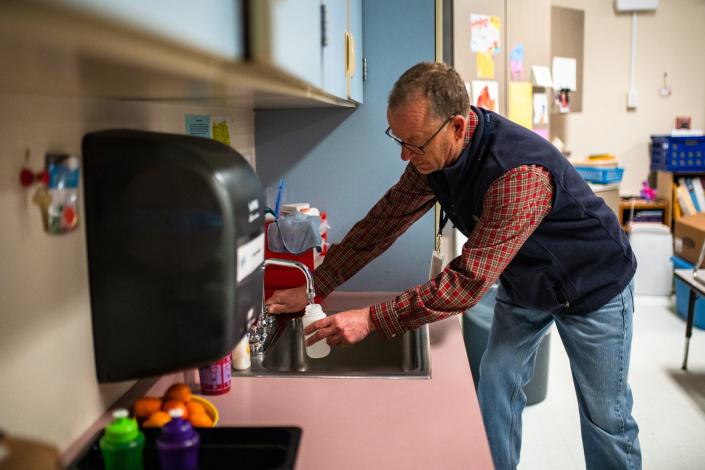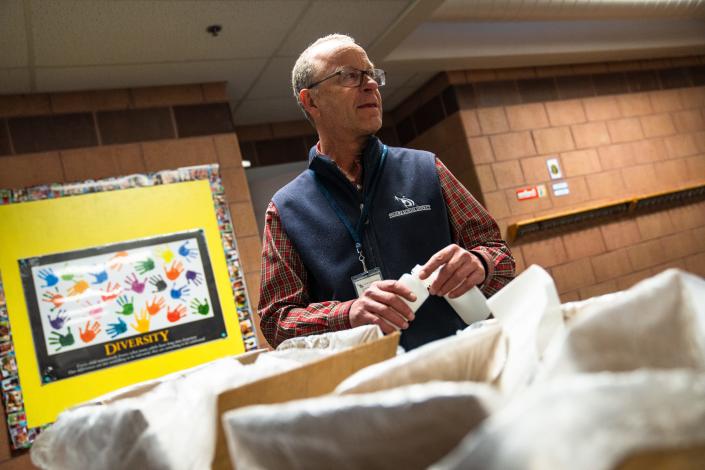Communications sent to parents can be alarming.
There’s lead in the water at your child’s school, read the emails.
Poudre School District has notified students, staff and families at 16 schools that lead levels exceeding state health and safety guidelines have been found in one or more fixtures that can be used for drinking water. Eighteen schools have been checked and received results so far.
As a result, those fixtures have been shut off until they can be tested and, if necessary, filtered, repaired or replaced to reduce the levels of lead in the water they supply.
The samples must still be collected at a handful of the other 14 non-chartered elementary schools in the district. Results of samples submitted for eight others have not yet been shared with the district or the public by the state health department.
As concerning as those early results might seem to staff and parents receiving those emails, an overwhelming majority of fixtures — even at schools where other fixtures have been turned off — are testing at levels well below the threshold, according to a state database.
The majority of water samples test below Colorado’s new lead standard

Overall, nearly 88% of the water samples submitted by PSD for testing by the Colorado Department of Public Health and Environment have tested below the state’s threshold of five parts per billion of lead, which is three times more stringent than the Environmental Protection Agency’s actionable threshold for lead in water of 15 parts per billion.
There is no “safe” level of lead in drinking water, according to the EPA.
Results available Tuesday showed that 18 of the 1,052 fixtures (1.5%) tested at PSD schools had exceeded the EPA threshold.
The Thompson and Weld RE-4 (Windsor-Severance) school districts have not yet submitted samples under the new testing program, officials said, but will do so prior to the May 31 deadline for K-5 schools.
Provided the state legislature appropriates the funds to do so, school districts will have to submit samples from schools serving students in grades 6-8 by Nov. 30, 2024, under the requirements of Colorado House Bill 22-1358, passed by Colorado lawmakers in May 2022. The testing and remediation requirements apply to all child care providers and public schools serving children from preschool through eighth grade.
Schools with lead below state threshold
All fixtures that could be used for drinking water have tested below the state threshold at two of PSD’s non-charter schools — Bauder and Harris Bilingual — as well as at one of its charter schools, Fort Collins Montessori. PSD’s public charter schools are responsible for collecting and posting their own results, said Madeline Noblett, the district’s chief information officer.
Schools with leads above the state threshold
Six PSD elementary schools with results on the state’s Test and Fix Water for Kids website had five or fewer of the 64 or more fixtures tested in its building exceeding the state threshold.
-
Rice Elementary: One of 73 fixtures tested above the threshold.
-
Bennett: 2
-
O’Dea: 2 (One is from a kitchen steamer, which the state has since said does not need to be tested because lead can’t be transmitted to students through food heated with steam, PSD environmental coordinator John Holcombe said Thursday.)
-
Irish: 3
-
Dunn: 4 (one is a kitchen steamer)
-
Putnam: 5
Other schools had more fixtures test above the threshold:
-
Cache la Poudre: 13
-
Laurels: 9
-
López: 12
-
Olander: 8
-
Riffenburgh: 12
-
Shepardson: 8
-
Tavelli: 17
Only three schools so far have had more than 25% of their fixtures test above the threshold:
-
Eyestones: 20 (30% of fixtures, including a kitchen steamer)
-
Polaris Expeditionary Learning: 18 (29%)
-
Beatties: 15 (27%, including a kitchen steamer)
Rivendell, a private elementary school in Fort Collins, submitted 18 samples that all came back well below the threshold, with levels of 1.1 parts per billion or less.
Stay up to date with this tracker: Does your child’s school have lead in its water?
How lead testing and remediation is done
Holcombe was at Johnson Elementary early Thursday morning, collecting samples from each fixture before staff or students arrived. The testing protocols for the initial sampling require drawing the first water to flow out of each fixture that day, he said.
Working from a diagram he had submitted to the state health department ahead of time, he filled the 250-milliliter bottles they had supplied, affixed the proper label the state had printed out for each one, and sealed them back up in the boxes in which they came to be sent back immediately via FedEx for testing.

Of the 1,201 samples from PSD that the state had updated testing results for through Tuesday, 147 — including eight kitchen steamers — had tested above the threshold. That’s 12.2%. The overwhelming majority of fixtures testing above the threshold were classroom sinks (103). There were far fewer issues with the drinking fountains (20) and water-bottle fillers (2), which are used by most students and staff for drinking water.
Once the first round of testing is complete, the fixtures where lead in concentrations above 5 parts per billion were found will be retested under state health department protocols, Holcombe said.
“Then we have to do flush samples, in which we’ve got to let the water run for at least 30 seconds and then take another sample to identify if it’s coming from the fixture or further into the system.”
PSD has performed only a handful of those so far, he said.
The next step is remediation, he said. The school district will work with the state on a remediation plan, adding filters, replacing fixtures or replacing the supply pipes, as necessary. The state budgeted up to $21 million from the general fund for the current fiscal year to reimburse school districts for remediation efforts to reduce levels of lead in school drinking water.
The city of Fort Collins and other water suppliers to PSD schools already test their water regularly for lead, Holcombe said, so any required remediation work would likely be within the school itself.
What to know about Thompson, Weld RE-4 school districts’ testing
The Thompson School District participated in a voluntary sampling program funded by a Colorado Department of Health and Environment grant in 2018-19 and is working with the state to have those results included on the new database, district environmental specialist Jess Arnold wrote in an email exchange with the Coloradoans.
Samples were taken from 2,645 sinks, drinking fountains and water-bottle fillers at every school in the district, and 3.9% required remediation actions, she wrote. Those remediation actions were completed in 2019.
TSD plans to test only the 150 or so fixtures serving students in preschool through fifth grade that required remediation during the previous testing process and those in any new schools that have opened since then, wrote Arnold.
The Weld RE-4 School District plans to test water fixtures only at its five noncharter elementary schools in May, district spokesperson Katie Smith said, and is currently submitting required information to the state health department to receive the necessary testing materials.
Reporter Kelly Lyell covers education, breaking news, some sports and other topics of interest for the Coloradoans. Contact him at [email protected], twitter.com/KellyLyell or facebook.com/KellyLyell.news.
This article originally appeared on Fort Collins Coloradoan: 12% of PSD schools’ water fixtures exceed state lead standard
